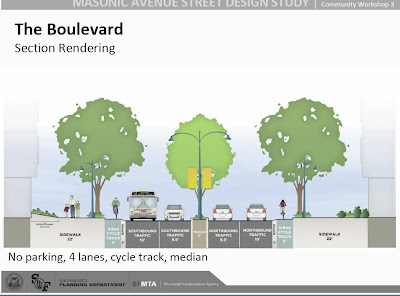

Improvements proposed for all Masonic corridor users and residents

Bicycle improvements were considered in both design options
The San Francisco Municipal Transportation Agency (SFMTA), the Planning Department, and the Department of Public Works released survey results this afternoon that confirm the preference of Masonic area residents for a full package of traffic calming measures along the corridor from Fell to Geary streets. The much-anticipated results indicate that more than three-quarters (76%) of the respondents either strongly liked or somewhat liked the Boulevard street design. More than half (55%) strongly liked it. The survey included another design treatment, the Gateway option, with fewer traffic calming measures. The data show that it was "a less desirable compromise" among the survey respondents with 64% of whom either liked or strongly liked it. Only 19% registered a "strongly liked" position. The survey data will help shape the final report and recommendations that city staff will complete by December 31st.
The Boulevard proposal includes streamlined traffic flow, pedestrian enhancements, Muni improvements, a separated bicycle lane, and a landscaped median. The new design will also remove round-the-clock street parking on Masonic, although SFMTA staff will propose creation of up to 80 new parking spaces nearby as a mitigation. In the survey, respondents favored the individual elements of the Boulevard design:
- transit facilities (53% strongly liked the features and 31% liked them)
- travel lane configuration including a median (47% strongly liked, 35% liked)
- lighting fixtures for roadway and pedestrian areas (66% strongly liked, 24% liked)
- raised bicycle track (54% strongly liked, 20% liked)
- parking removal (42% strongly liked, 17% liked)
- street trees (64% strongly liked, 21% liked)
In all the above categories, survey respondents favored the Boulevard treatments over the Gateway features. Written comments indicated the preferences were largely due to the extra enhancements in the Boulevard option. For example, a landscaped median the length of the Masonic blocks seemed to tip preferences for the travel lane configuration over the Gateway plan with intermittent medians.
The cycle track for bicyclists in the Boulevard design was much more popular than the striped bike lane proposed under the Gateway option. In the latter, only 15% strongly liked the lesser lane treatment with another 40% indicating they liked it. Not surprisingly, the removal of parking proved to be the issue that divided respondents the most. But, according to the report, "a stronger and larger majority (are) in favor of removing all parking." Even so, many respondents expressed strong reservations. The Gateway proposal contained removal of parking on just one side of the street, but 17% strongly disliked the idea and another 29% disliked it. The greater number of street trees proposed in the two plans (200 for the Boulevard, 125 for the Gateway) easily swayed the strongly liked response for the Boulevard.
Javad Mirabdal, project manager for the Masonic study, explained the process that led to the results released today.
This is basically what the community told us. We worked with the community during three community meetings and narrowed the options to these last two, the Boulevard and the Gateway. The majority are in favor of the Boulevard option, and we will include the data in our final report and recommendations.
Mirabdal added that the next step will be to legislate the proposal with public support. "Then we have a project," he said. With the approval in hand, city staff will complete the design, seek environmental review if needed, and begin the challenging task of securing funding.
For related stories, see the A Better Masonic series.



































